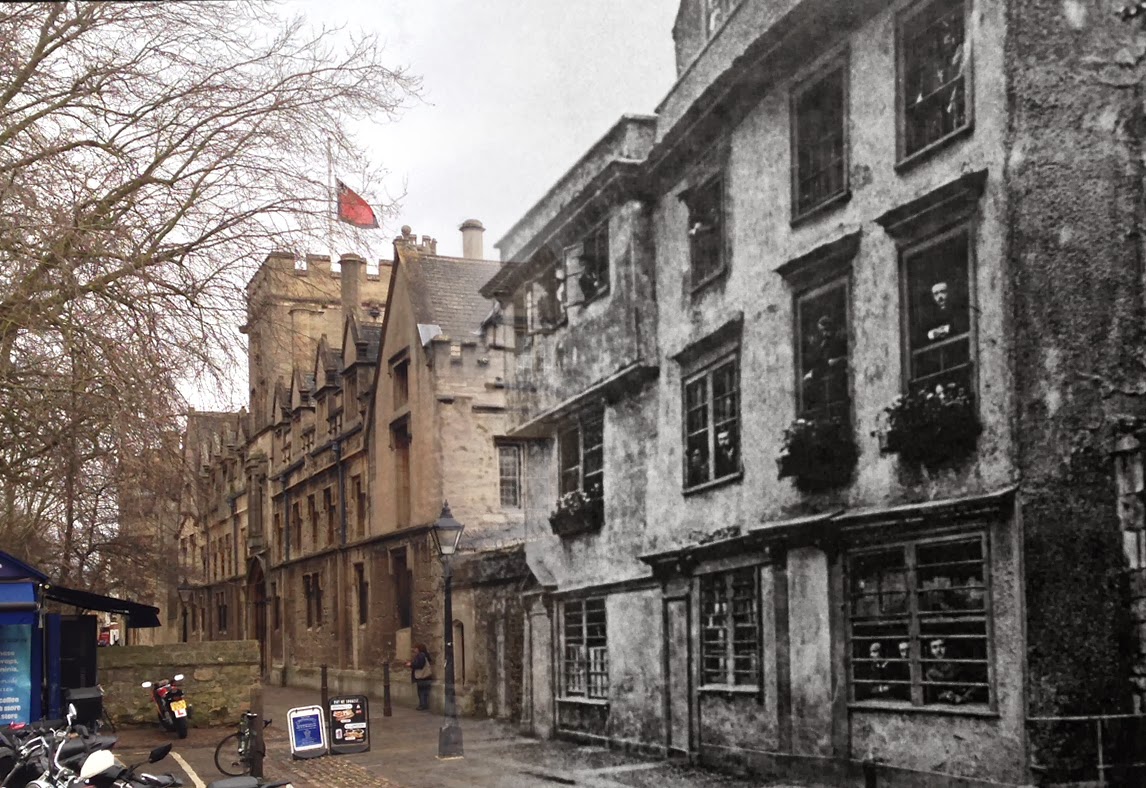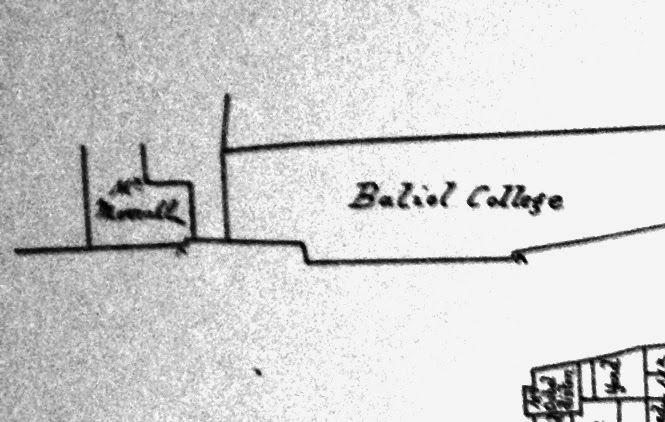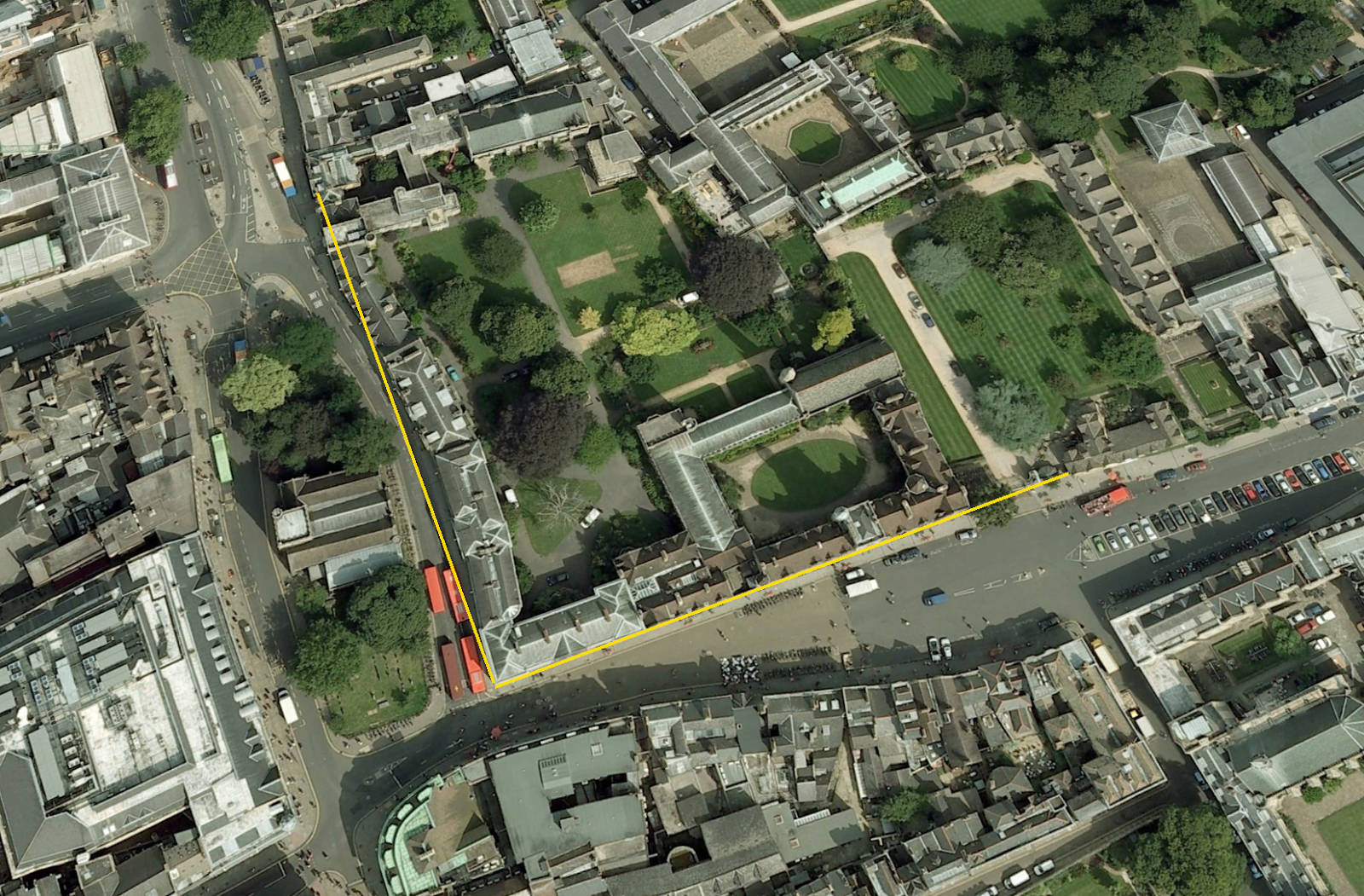The Dolphin Inn (now demolished), which was run by my 6 x great-grandfather Samuel Stevens between (at least) 1734-1772. The photograph of the inn was taken some time around 1870; the modern photograph on my way to work today.
The Dolphin Inn
After my last post about my 6 x great-grandfather, Samuel Borton’s residence, I wanted to see if I could find out the name of the inn he owned, which, I now knew stood at the southern end of St. Giles. In a book of old Oxford photographs, which I bought a few years back, I found the following image:
It shows St. John’s college and a building next door called the Dolphin building, which at the time of this photograph c1870 was part of the college. The text beneath the photograph stated that it had once been an inn, and digging a little deeper, I discovered that it had indeed been the Dolphin Inn.
This then is a photograph of my 6 x great-grandfather’s inn before it was demolished.
The engraving below, is that of the same inn, made in 1779, probably at the time when my ancestor was resident.
More on Samuel Borton in 1772
Following on from my last post on Samuel Borton’s residence, I’ve found evidence confirming where he lived. The following image shows his name in the survey:
I took the photo below whilst standing in my bus queue this evening. It shows the row of buildings which, I believe, stand on the site of those buildings once occupied by Messrs Morrel, Fidler and my ancestor, Borton.
Looking at a plan from the 1772 survey – which I’d photocopied several years ago – I discovered that this is indeed the site of my ancestors dwelling.
The following is a close up of the top left hand corner.
The name in the ‘box’ next to Balliol College is Mr. Morrell, which when we look at the list at the top of the page is the first name after Balliol College. His property would have stood approximately where the orange-brown neo-classical building stands now. Four yards to the left would have been Mr Fidler’s property and occupying the land next to that would have been my ancestor’s property, which I believe was an inn.
Samuel Borton in 1772
I have recently written about John Gwynn’s survey of Oxford (1772) in relation to my family tree research (see Lydia Stevens 1734-1822) and have discovered another ancestor in the same survey. Lydia’s father, Samuel Borton was, at the time of her birth, an innkeeper in Mary Magdalen Parish. Lydia married John Stevens in the church of St. Mary Magdalen in 1764, and I wondered therefore whether Samuel Borton would be listed in Gwynn’s survey? Sure enough, in Magdalen parish, close to Balliol College, a Mr. Borton is listed as the owner of a property measuring 15 yards wide.
I need to get a copy of H.E. Salter’s Survey of Oxford in 1772 with Maps and Plans to work out where exactly this is (the above extract is from Google books). However, it might be that as we have [Here Broad St.] and given that the length of Balliol College is given as 140 yards (128 metres), that Mr. Borton’s property is on the north side Broad Street. But then Balliol College, west end would seem to be that part of the college shown in yellow below. In which case Mr. Borton’s property would actually be nearer St. Giles.
Having looked up Broad Street in Google Earth, I decided to use the measuring tool to see if that would help. The yellow lines are both approximately 140 yards long.
Superimposing the 1750 map above onto Google Earth, we get the following:
A closer look:
Samuel Borton (1706 – ?)
During a quick research session in the library this lunchtime, I tried to discover the birth date of my 6 x great-grandfather, Samuel Borton. Having trawled through the indexes for St. Martin’s parish, St. Mary Magdalen, St. Peter le Bailey and St. Mary the Virgin, I turned to that for Holywell parish. In there I discovered a Samuel Borton born in 1706. His father was listed as Richard and in the time I had, I discovered two siblings called Ann (b.1693) and Mary (b.1703).
From the index it’s hard to say for sure that this Richard Borton is the father of my Samuel Borton, but the name isn’t common and, in line with what I described yesterday, another piece of evidence could be gleaned from the names of Samuel’s own children.
His first son was called Samuel (1737 – ); his second son, surely named after his grandfather – Richard, born in 1739.
John and Samuel
The name of a first born son or daughter is a good way of confirming whether or not your research, as regards a particular family line, is on the right track, and this has been the case with my current research into the Stevens line (my mother’s father’s line) of my family tree.
The father of my 3 x great-grandfather, John Stevens (1811-1876) was, I believe, a Samuel Stevens (1776-1841) and his father in turn was another John Stevens (1737-1803).
The name John is clearly important. John (1737-1803) named his first son John. He appears to have died in infancy as John’s fourth son (seventh child) was also named John. Sadly, this child also seems to have died in infancy; the couple’s fifth son (eighth child) was also named John. The couple’s third son (fourth child) was named Samuel (b1769) who again appears to have died in childhood. Another Samuel (my direct ancestor and the couple’s ninth child) was born seven years later in 1776. This shows that the name Samuel was also important.
This Samuel (1776-1841) had several children including a Samuel (first son, born in 1808) and a John (my direct ancestor born in 1811). John also had many children; his first born was John (1837-1888) and his second son was Samuel (1839-1919). My direct ancestor, Jabez (1847-1899) also had children, none of whom were called John or Samuel. Indeed, the name doesn’t appear again in my direct family line. One reason for this falling out of favour might be that John Stevens (1837-1888) spent much of the last part of his life in Moulsford Asylum. With the loss of his income his wife Emma entered a workhouse with two of her children, Martha and Kate, where she died of cancer in 1873.
The important point is that my 3 x great-grandfather’s second son was Samuel; it links him with the Samuel Stevens who I believe to be my 4 x great-grandfather. But where does the name Samuel come from? Why was it so important?
Going through the Oxfordshire parish indexes last week I discovered the following: my 5 x great-grandfather John Stevens (1737-1803) was married to Lydia Borton (1734-1822) in the church of St. Mary Magdalen on 24th March 1764. The witnesses are given as Sam Borton and Mary Stevens. In the records I discovered that Lydia’s father was Samuel Borton, an innkeeper in the parish of St. Mary Magdalen. So, that must be where the name comes from as regards its important in the Stevens line.
The elusive Samuel Stevens (1776 – ?)
I’ve turned my attention to my 4 x great-grandfather Samuel Stevens who I know was born in Oxford in 1776. I know too that he married a woman called Mary and that they had a child called John (my 3 x great-grandfather) in 1811.
In the library this afternoon I tried to find details of other children they might have had and the date and location of their wedding; however I couldn’t find anything save for details of a daughter, Frances, born in St. Aldate’s Parish in 1809, two years before John. However that was it, which led me to suspect that either one or both had died after John’s birth, or that they had moved away – which seemed the more likely.
Given that John lived in Reading for much of his life, it seemed plausible that it was actually his parents who moved some time after his birth in 1811. Searching through the records online, I eventually found a Samuel Stevens who married a Mary Pecover in St. Lawrence Parish, Reading on May 14th 1807. This I’m sure must be my ancestor; not only does the place fit – along with the name of his wife – but the date of the wedding – two years before the birth of Frances – also fits the wider picture. It seems therefore that having married Mary in Reading, they moved to Oxford but left shortly after to return to Reading.








